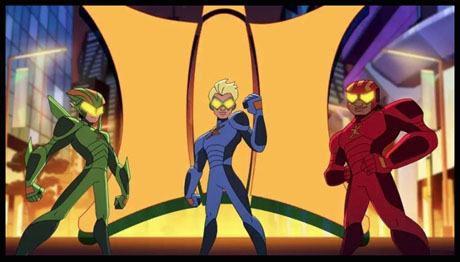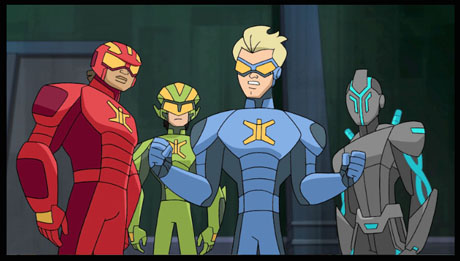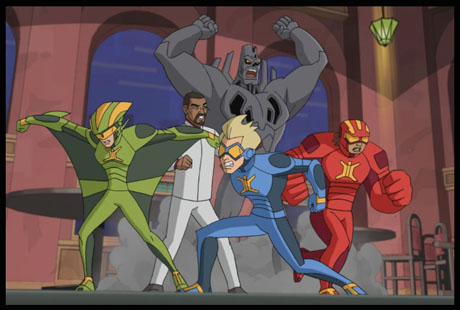
There have been numerous movies and TV shows involving toys coming to life. But never one quite like this. Victor Cook, executive producer of Hasbro’s animated series Stretch Armstrong and the Flex Fighters expands on Season 2, now streaming on Netflix. But first he recaps Season 1, in which three ordinary teens – Jake Armstrong, Nathan Park and Ricardo Perez – become superheroes.
Victor Cook: In Season 1 this accident happens to them. And this guy, Jonathan Rook, this businessman who created and re-built Charter City, hires them as corporate superheroes. The chemical accident that created these three guys has been creating these supervillains, we find out all season. By the end of the season… we find out that Jonathan Rook is actually Stretch Monster and the guy behind all these “accidents” creating these monsters. And our heroes find that out in the last episode. Rook/Stretch Monster frames them for a crime that they didn’t commit. So Season 2 is about them being… rogue heroes, in a way. The world does not know Rook is Stretch Monster, and everyone now thinks our good guys are the bad guys.

Jackson Murphy: Congratulations on Season 2. You never know how long shows are going to last. You and your team must be very proud.
VC: We’re really excited. Season 1 was the foundation. We introduced all these characters. And the status quo of Season 1 radically changed at the end, and so Season 2 is an opportunity to see our heroes work under a different kind of pressure. We get to peel away some of the onion skin of story and character development and learn more about these guys.
JM: And there’s a real reason why this show is called “Stretch Armstrong AND the Flex Fighters”. It’s not just about Stretch. It’s got an ensemble to it, and… this is a very diverse show.
VC: Very diverse. On most shows,if you’re doing a show based on a known property, you have to deal with what was set before. But you find ways to modernize it. But with this show, there was no real story to it before. It was just a novelty toy. You didn’t know who he was. You didn’t know what his job was. It was just a thing you played with like a frisbee. So we were able to create a whole brand new superhero universe around it, and it’s a show about a team. We could, from the get go, cast these characters any ethnicity and any race and any gender we wanted. And we decided to have a reflect a modern, big city that you’d see in America today.
JM: I remember five or six years ago hearing that there was going to be a live-action “Stretch Armstrong” movie that didn’t end-up happening. I’m glad that this animated series was able to come out of that.
VC: Hasbro had been trying to crack the nut of developing the “Stretch Armstrong” property into some sort of a narrative. By the time me and my producing partners Doc Wyatt and Kevin Burke came in, we were given a blank slate. They said, “It has to still be called ‘Stretch Armstrong’. He still has to be able to stretch. But other than that: show us what you got.” And that’s what we did.

JM: Hasbro Studios has been very protective of this brand, but it’s nice that they’ve given you this freedom to create this how you would.
VC: We just said, “Let’s create a superhero universe that WE would like.” We decided to make it about a team. And we wanted them to be teenagers because teenagers are inexperienced anyway. We just thought it would be more fun and interesting to see them go through these superpowers together. We gave them three distinctive personalities, so we could experience it through those points of view.
JM: Did you ever have any aspirations in high school that you would, suddenly, like to become a superhero and fight crime?
VC: (laughs) If you asked me if wished I had any kind of superpower, I think it would be flying. But no, I didn’t ever think in high school I wanted to be a superhero. I think maybe when I was 6, I wanted to be a superhero. By the time I got into high school, my aspiration was to draw superheroes and be a cartoonist.
JM: And who were some of your inspirations growing up? Were they comic book artists, like Stan Lee, who you looked up to?
VC: I was a kid in the late 60s, so one of my big heroes was Jack Kirby, who was the artist of the Marvel Universe. And I just loved the power and dynamics of what he did. On the other side of the spectrum of the cartoon world, my other hero was Charles Schulz (the creator of Peanuts) – two radically different things. And because of those two, I thought I wanted to be a print cartoonist. It wasn’t really until college that the idea of getting into animation came to me – and to use those skills of cartooning and comics for animation.
JM: And at what point in your timeline of life did Stretch Armstrong come into play?
VC: The toy, I think, came out in 1978, so I was a sophomore in high school then. I remember seeing it. My younger brother had it, so I didn’t actually play with one. I was not into that kind of toy. I was more into superhero toys, so I was into the Mego figures – they had a storyline; they reminded me of a comic strip. But I do remember my brother and his buddies playing with the Stretch Armstrong. So it was great, years later, that I was able to create that comic book superhero world around that character.

JM: Did you ask your brother, “Hey, do you remember how you played with that?” for some inspiration?
VC: (laughs) No, not really, because honestly the show is nothing like the original toy at all. The original toy: he’s walking around in a pair of shorts. He looks like a wrestler. He was just this thing you played with. He was a thing. So inspirations for this show were my love of comic books and superheroes – and envisioning a world like that the way I see it. The only thing we really have in common with the original toy is that he stretches, but we have our own way of how he does it. He wore blue trunks, so his costume is blue. He had blonde hair, so we decided to make Jake Armstrong have blonde hair.
And in observing other superhero characters stretch, we’ve seen that they can sort of, by will, make their arms stretch out or turn into the shape of a boat. We really wanted to do it a little bit differently on this show. So we kind of envisioned him as a human bungee chord or a human rubber band, which means something else has to stretch it. And when you let go of one end, it’s gonna snap back into shape. Stretch is like centrifugal force or gravity or if he’s doing some acrobatic flips forward, it will stretch out but get to a certain point, and it will stretch back. So usually he’ll grab onto a ledge and that will slingshot him. And when we came up with that, that was the key to the action choreography to “Stretch”, too.
JM: And are those moments the toughest for the animators to animate?
VC: Oh, yeah, because of so many in-betweens. Superman, for instance. If he’s flying, you could get away with him in a three-quarter flying pose and have the background just kind of pan – but he’s hardly moving. But with a character like Stretch Armstrong, to execute his powers, it’s just constant movement and constant motion. It took a lot more drawings and it was a lot harder for the animators to do. But for the storyboard artists who could dream-up what was going to happen, it made it super fun.
JM: And you’ve got someone great voicing Jake/Stretch, Scott Menville. And he’s no stranger to voicing superheroes. He’s also Robin on “Teen Titans Go!” and in the hilarious new movie.
VC: Scott is amazing. He brings a lot of depth to the character. There’s the superhero side of Stretch, but there’s also his alter-ego. He’s an over-stressed, over-scheduled teenager raised by a single dad. His dad’s kind of a tiger dad, wanting him to excel at every subject and prepare for his future. So there’s tension between him and his dad, and Scott pulls off those emotional scenes as well as the heroic scenes.
JM: I recently interviewed Eric Bauza, who gets to voice two villains this season. Tell me about them.
VC: Eric showed-up in Season 1 in an episode that featured another villain called “Smokestack”. There was a meeting of all these gangs in Act 3, and Bauza played Murakami, the leader of the Daggers (one of those gangs), so that was his first appearance. And in Season 2, we have an episode called “Riya’s Revenge” where we get into knowing her backstory more. And he reprises Murakami… but he also shows up as a new villain called The Gentleman: a proper Englishman of Indian ancestry who is super well-mannered, British, loves tea. But he wears a super strong exoskeleton suit, so he’s very polite as he’s pounding you.
JM: What do you think is the next toy that could be adapted into a series (and one that you would want to work on)?
VC: Oh, wow. There’s so many. I wouldn’t mind if they rebooted “G.I. Joe.” If somebody wanted to reboot “G.I. Joe” and wanted to give me a call, I’d love to work on that. That’d be fantastic.
JM: We’ve had a couple of live-action movies. So this would be a new, reinvented animated series?
VC: And maybe not so much for kids. Kids could watch, but maybe it would be done a little more… anime… older. Yeah, that would be fun to do.
- INTERVIEW: “Inside Out 2” Director And Producer On Pixar Sequel - April 16, 2024
- INTERVIEW: “Puffin Rock And The New Friends” And 25 Years Of Cartoon Saloon - April 10, 2024
- INTERVIEW: “Chicken For Linda!” Directors On Annecy Winning Feature - April 9, 2024


 October 3rd, 2018
October 3rd, 2018  Jackson Murphy
Jackson Murphy  Posted in
Posted in  Tags:
Tags: 






